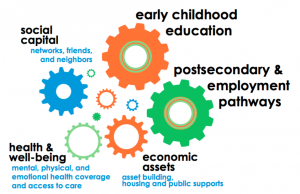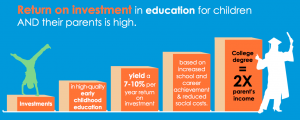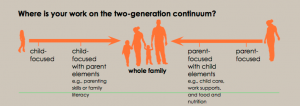Amazing organizations are working hard to support the development and achievements of young children. Similarly, outstanding organizations are working hard to connect adults with the proper resources to attain success.
Supporting each of those populations separately would naturally complement the other. However, recent reflection on this topic has shown that intentionally supporting the development and personal growth of children and adults together (a two-generational approach) can have a larger, positive impact on both generations. By working simultaneously together, it ensures that programs and services are not fragmented and, therefore, do not leave either the child(ren) or adult(s) behind.
Research has documented the impact of a parent’s education level, financial stability, and even overall health as negatively or positively affecting their child’s outcomes. Similarly, children’s education and healthy development have significant parental implications.
WHAT IS A TWO-GENERATIONAL APPROACH?
The Ascend program at the Aspen Institute gives an overview of a two-generational approach:
“Two-generation approaches provide opportunities for and meet the needs of children and their parents together. They build education, economic assets, social capital, and health and well-being to create a legacy of economic security that passes from generation to the next.”
Ascend identifies four core components needed to create a successful two-generational approach:
- Education
- Economic assets
- Social capital
- Health and well-being
The Annie E. Casey Foundation is another organization that has analyzed a two-generational approach and has outlined three key components:
- Provide parents with multiple pathways to get family-supporting jobs. This leads to achieving financial stability.
- One study found that children whose family income was below the federal poverty level — which today is about $24,000 for a family of four — completed fewer years of school, worked and earned less as adults, relied more on food assistance, and suffered from poorer health than kids whose family income was at least twice that level. However, an extra $3,000 annually for these families during a child’s earliest years could translate into an increase of more than 15 percent in what that same child earns as an adult.
- Ensure access to high-quality early childhood education and enriching elementary school experiences.
- Greater coordination among early learning centers, schools, and other programs for kids can further support healthy development from birth through the early elementary years.
- Equip parents to better support their children socially and emotionally and advocate for their kids’ education.
- When parents can reduce their stress and anxiety, they can better respond to their children’s emotional needs.
Simply put, a two-generational approach looks at what both the parent(s) and child(ren) need and works to provide the necessary resources (education, healthcare, childcare, etc.) for both generations to be successful.
GREAT FAMILIES 2020
United Way of Central Indiana (UWCI) is applying this emerging research of a two-generation approach and modeling it in its Great Families 2020 Social Innovation Fund initiative. Great Families 2020 is a five-year initiative to improve family stability for vulnerable children and their parents living in four neighborhoods in Indianapolis. Great Families 2020 will pilot a two-generation approach, where neighborhood networks in education (including high-quality early childhood education), financial stability (Center for Working Families), and health services are integrated to serve the whole family.
This initiative’s funding consists of a $7 million federal Social Innovation Fund grant and matching dollars from the community for a total investment of approximately $20.6 million.
UWCI announced its final four programs to implement the Great Families model in its neighborhood. Our President, Amanda Lopez, was invited to help select the community grantees.
WHAT CAN YOU DO?
Your organization may not have a multi-million dollar federal grant to implement this research, but there are still steps that you can take:
-
- Review the research. To stay informed, familiarize yourself with this approach and initiatives underway nationally and locally. Knowledge is power!
- Review your current programs and funding focus. Perhaps you will see that you have fragmented services that are missing that other generation. Can you partner with other agencies to accelerate the accomplishment of your goals? Can you apply for funding that supports a two-generation approach?
- Reach out. Sometimes, the best way to reflect on growth opportunities is to connect with organizations successfully modeling your ideal funding stream/program/outreach strategy, etc. So, use the research you will do to connect with organizations that successfully use a two-generation approach to achieve more significant impact and hear how they are doing it.
At Transform Consulting Group, our clients work with both populations: young children and their parents. We help our clients increase their partnerships internally within their organization or externally with other partners to improve outcomes for children and parents. If you want to learn more about two-generation approaches or funding opportunities to support your work, please contact us for a free consultation!


